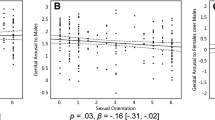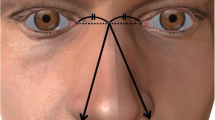Abstract
The relation between sexual orientation andpenile dimensions in a large sample of men was studied.Subjects were 5122 men interviewed by the KinseyInstitute for Research in Sex, Gender, and Reproduction from 1938 to 1963. They were dichotomouslyclassified as either homosexual (n = 935) orheterosexual (n = 4187). Penile dimensions were assessedusing five measures of penile length and circumferencefrom Kinsey's original protocol. On all fivemeasures, homosexual men reported larger penises thandid heterosexual men. Explanations for these differencesare discussed, including the possibility that these findings provide additional evidence thatvariations in prenatal hormonal levels (or otherbiological mechanisms affecting reproductive structures)affect sexual orientation development.
Similar content being viewed by others
REFERENCES
Bailey, J. M., and Pillard, R. C. (1991). A genetic study of male sexual orientation. Arch. Gen. Psychiat. 48: 1089–1096.
Bailey, J. M., and Zucker, K. J. (1995). Childhood sex-typed behavior and sexual orientation: A conceptual analysis and quantitative review. Dev. Psychol. 31: 43–55.
Bailey, J. M., Willerman, L., and Parks, C. (1991). A test of the maternal stress theory of human male homosexuality. Arch. Sex. Behav. 20: 277–294.
Baskin, L. S., Sutherland, R. S., DiSandro, M. J., Hayward, S. W., Lipschutz, J., and Cunha, G. (1997). The effect of testosterone on androgen receptors and human penile growth. J. Urol. 158: 1113–1118.
Blanchard, R., and Bogaert, A. F. (1996). Biodemographic comparisons of homosexual and heterosexual men in the Kinsey interview data. Arch. Sex. Behav. 25: 551–579.
Bogaert, A. F., and Blanchard, R. (1996a). Physical development and sexual orientation in men: Height, weight, and onset of puberty differences. Pers. Indiv. Diff. 21: 77–84.
Bogaert, A. F., and Blanchard, R. (1996b). Handedness in homosexual and heterosexual men in the Kinsey interview data. Arch. Sex. Behav. 25: 373–378.
Byne, W., and Parsons, B. (1993). Human sexual orientation: The biologic theories reappraised. Arch. Gen. Psychiat. 50: 228–239.
Conte, F., and Grumbach, M. (1995). Pathogenesis, classi. cation, diagnosis, and treatment of anomalies of sex. In Degroot, L. J. (ed.), Endocrinology, W. B. Saunders, Philadelphia.
Dörner, G., Geier, T., Ahrens, L., Krell, L, Münx, G., Sieler, H., Kitter, E., and Müller, H. (1980). Prenatal stress as possible aetiogenic factor of homosexuality in human males. Endokrinologie 75: 365–368.
Ellis, L., and Ames, M. A. (1987). Neurohormonal functioning and sexual orientation: A theory of homosexuality-heterosexuality. Psychol. Bull. 101: 233–258.
Freedman, M. (1975). Homosexuals may be healthier than straights. Psychol. Today 8: 28–32.
Gebhard, P. H., and Johnson, A. B. (1979). The Kinsey Data: Marginal Tabulations of the 1938- 1963 Interviews Conducted by the Institute for Sex Research, W. B. Saunders, Philadelphia.
Geschwind, N., and Galaburda, A. M. (1985). Cerebral lateralization. Biological mechanisms, associations, and pathology: II. A hypothesis and a program of research. Arch. Neurol. 42: 634–654.
Hamer, D. H., Hu, S., Magnuson, V. L., Hu, N., and Pattatucci, A. (1993). A linkage of DNA markers on the X chromosomes and male sexual orientation. Science 261: 321–327.
James, W. J. (1989). Foetal testosterone levels, homosexuality, and handedness: A research proposal for jointly testing Geschwind' and Dörner' hypothesis. J. Theoret. Biol. 136: 177–180.
Jamison, P., and Gebhard, P. (1988). Penis size increase between flaccid and erect states: An analysis of the Kinsey data. J. Sex Res. 24: 177–183.
Kinsey, A. C., Pomeroy, W. B., and Martin, C. E. (1948). Sexual Behavior in the Human Male, W. B. Saunders, Philadelphia.
LeVay, S. (1991). A difference in hypothalamic structure between heterosexual and homosexual men. Science 253: 1034–1037.
Levy, J. B., and Husmann, D. (1996). Congenital adrenal hyperplasia: Is there an effect on penile growth? J. Urol. 156: 780–782.
Lindesay, J. (1987). Laterality shift in homosexual men. Neuropsychologia 25: 965–969.
Nedoma, K., and Freund, K. (1961). Somatosexulní nálezy u homosexuálních mužu [Somatosexual findings in homosexual men]. Ceskoslovenska Psychiatre 57: 100–103.
Siever, M. D. (1994). Sexual orientation and gender as factors in socioculturally acquired vulnerability to body dissatisfaction and eating disorders. J. Consult. Clin. Psychol. 62: 252–260.
Siminoski, K., and Bain, J. (1993). The relationship among height, penile length, and foot size. Ann. Sex Res. 6: 231–235.
Sutherland, R. S., Kogan, B. A., Baskin, L. S., Mevorach, R. A., Conte, F., Kaplan, S., and Grumbach, M. M. (1996). The effect of prepubertal androgen exposure on adult penile length. J. Urol. 156: 783–787.
Swaab, D. F., and Hofman, M. A. (1990). An enlarged suprachiasmatic nucleus in homosexual men. Brain Res. 537: 141–148.
Takane, K. K., George, F., and Wilson, J. D. (1990). Androgen receptor of rat penis is down-regulated by androgen. Am. J. Physiol. 258: E46.
Tripp, C. A. (1975). The Homosexual Matrix, McGraw-Hill, New York.
Ward, I. L. (1984). The prenatal stress syndrome: Current status. Psychoneuroendocrinology 9: 3–11.
Ward, I. L. (1992). Sexual behavior: The product of perinatal hormonal and prepubertal social factors. In Gerail, A. A., Moltz, H., and Ward, I. L. (eds.), Handbook of Behavioral Neurobiology: Vol. 11. Sexual Differentiation, Plenum Press, New York.
Ward, I. L., and Weisz, J. (1980). Maternal stress alters plasma testosterone in fetal males. Science 207: 328–329.
Zilbergeld, B. (1978). Male Sexuality, Little, Brown, Boston.
Zucker, K. J., and Bradley, S. J. (1995). Gender Identity Disorder and Psychosexual Problems in Children and Adolescents, Guilford, New York.
Zucker, K. J., Bradley, S. J., Oliver, G., Blake, J., Fleming, S., and Hood, J. (1996). Psychosexual development of women with congenital adrenal hyperplasia. Horm. Behav. 30: 300–318.
Rights and permissions
About this article
Cite this article
Bogaert, A.F., Hershberger, S. The Relation Between Sexual Orientation and Penile Size. Arch Sex Behav 28, 213–221 (1999). https://doi.org/10.1023/A:1018780108597
Issue Date:
DOI: https://doi.org/10.1023/A:1018780108597




